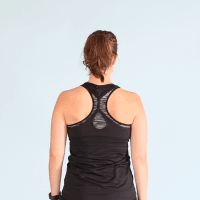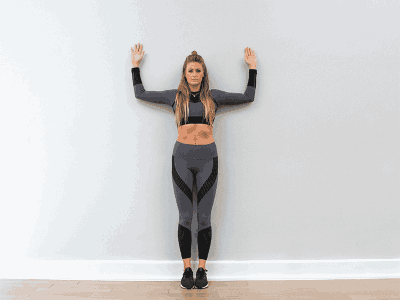Shoulder pain while running can be a debilitating issue for many athletes and fitness enthusiasts. It not only affects your performance but can also lead to long-term discomfort if left unaddressed. In this comprehensive guide, we will delve deep into the common causes of shoulder pain during running, explore effective treatments and preventive measures, and provide you with a set of exercises to help you regain pain-free runs. Let’s not allow shoulder pain to sideline your passion for running; instead, let’s work together to get you back on the track, quite literally!
Contents
Understanding the Dilemma
Shoulder pain during running is a perplexing problem. Unlike lower body injuries, which are more common among runners, shoulder pain is often a neglected topic. However, it’s a vital issue to address, especially for those who engage in long-distance running, trail running, or any activity that involves arm movement.
Here are some of the common causes of shoulder pain while running:
- Poor Running Posture: Your running posture plays a crucial role in maintaining proper body mechanics. Slouching or hunching your shoulders can lead to muscle imbalances and shoulder strain.
- Carrying Extra Weight: Carrying a heavy backpack or hydration pack on one shoulder while running can lead to an imbalance in weight distribution. This, in turn, can cause overuse and strain in the shoulder muscles.
- Overuse and Repetitive Movements: Engaging in repetitive arm movements while running, such as excessive arm swinging or tightly gripping your handheld water bottle, can strain the shoulder joint and its surrounding structures.
- Rotator Cuff Issues: Conditions like rotator cuff tendinitis or tears can result in radiating pain in the shoulder during running. These injuries can be exacerbated by the arm movements involved in running.
- Nerve Compression: Nerves in the neck and upper back can become compressed due to poor posture or spinal issues. This compression can lead to referred pain in the shoulders while running.
- Underlying Medical Conditions: Certain medical conditions like osteoarthritis, rheumatoid arthritis, or bursitis can affect the shoulder joint. Running can exacerbate the pain associated with these conditions.
- Muscle Imbalances: Weakness or imbalances in the muscles supporting the shoulder joint can result in poor stability. This can lead to pain, especially during activities like running that involve significant arm movement.
- Trauma or Injury: Previous shoulder injuries, such as dislocations, fractures, or sprains, can cause persistent pain, which may be triggered or worsened by running.
- Age-Related Changes: As we age, the shoulder joint may undergo degenerative changes, leading to conditions like osteoarthritis. Running can exacerbate the discomfort caused by these changes.
- Inflammatory Conditions: Inflammatory conditions like bursitis or tendonitis can cause pain in the shoulder area. The repetitive arm swinging motion during running may aggravate these conditions.
Understanding these factors can help you identify the root cause of your shoulder pain while running, paving the way for effective treatment and relief.
Tackling Shoulder Pain During Running
 Shoulder pain during running is not something you have to endure. There are several approaches you can take to alleviate discomfort and prevent future issues. Here’s a comprehensive guide to help you get started:
Shoulder pain during running is not something you have to endure. There are several approaches you can take to alleviate discomfort and prevent future issues. Here’s a comprehensive guide to help you get started:
1. Rest and Ice: If you’ve recently developed shoulder pain due to overuse, start with rest. Avoid activities that exacerbate the pain and apply ice to the affected area for 15-20 minutes several times a day. This can help reduce inflammation.
2. Pain Medications: Over-the-counter pain relievers like ibuprofen or acetaminophen can help manage pain and inflammation. It’s essential to follow the recommended dosage and consult a healthcare provider if necessary.
3. Posture Correction: Focus on maintaining proper posture while running. Stand or walk with your shoulders relaxed and your back straight. Avoid slouching or leaning forward, as this can strain the shoulder muscles and lead to discomfort.
4. Reduce Bag Weight: If carrying a bag is contributing to your shoulder pain while running, minimize the weight you carry. Consider using a backpack with two shoulder straps to distribute weight evenly across your back and shoulders.
5. Physical Therapy: Consult a physical therapist who can design a customized exercise program to improve shoulder strength and flexibility. These exercises can address muscle imbalances and improve overall joint stability.
6. Corticosteroid Injections: In cases of severe pain and inflammation, a doctor may recommend corticosteroid injections into the shoulder joint to provide targeted relief.
7. Ultrasound Therapy: This non-invasive treatment uses ultrasound waves to generate heat and promote blood flow to the affected area, aiding in the healing process.
8. Activity Modification: Adjust your running routine to reduce strain on your shoulders. Avoid excessive arm swinging or high-impact activities that worsen your pain.
9. Massage Therapy: Consider massage therapy to relax tight shoulder muscles and improve circulation. A skilled therapist can work on specific areas to relieve pain.
10. Orthopedic Evaluation: If your pain persists or worsens, consult an orthopedic specialist for a thorough evaluation. They can identify any structural issues or underlying conditions requiring specific treatment.
11. Surgery: In rare cases, surgery may be necessary, especially if there’s a significant structural problem, such as a rotator cuff tear. Surgical options range from minimally invasive arthroscopy to traditional open surgery.
It’s essential to consult a healthcare provider to determine the underlying cause of your shoulder pain and create an appropriate treatment plan. Delaying treatment can lead to further complications or chronic pain, so seek medical attention promptly if needed.
Exercises to Relieve Shoulder Pain While Running
Experiencing shoulder pain while running can be discomforting, but specific exercises can help alleviate the pain and improve your shoulder’s strength and mobility. Here are some exercises tailored to address shoulder pain while running:
Pendulum Exercise
- Stand or lean over a table with your unaffected arm supporting your upper body.
- Allow your affected arm to hang freely.
- Gently swing your affected arm in small circles, both clockwise and counterclockwise.
- Perform 10-15 circles in each direction.
- This exercise helps relax and gently mobilize the shoulder joint.
Shoulder Blade Squeezes

- Sit or stand with your arms by your sides.
- Squeeze your shoulder blades together as if you’re trying to hold a pencil between them.
- Hold this position for 5 seconds, then relax.
- Repeat this exercise for 10-15 repetitions.
- Shoulder blade squeezes help improve posture and strengthen the muscles around the shoulder blades.
Isometric Shoulder Exercises
- Hold a small ball, rolled-up towel, or resistance band between your hands.
- Gently press your hands together while keeping your elbows bent at 90 degrees.
- Hold the contraction for 5-10 seconds, then relax.
- Repeat this exercise 10-15 times.
- Isometric exercises engage the shoulder muscles without causing excessive movement.
Wall Angels

- Stand with your back against a wall, feet about 6 inches away from the wall.
- Bend your elbows at a 90-degree angle, so your upper arms are parallel to the floor.
- Slowly slide your arms up the wall as far as you can without pain, keeping your elbows and wrists in contact with the wall.
- Hold this position for a few seconds, then slide your arms back down.
- Perform 10-15 repetitions.
- Wall angels improve shoulder mobility and strengthen the rotator cuff muscles.
Rotator Cuff Strengthening
- Using a resistance band, anchor it at waist height.
- Stand with your side to the anchor point and hold the band in your affected hand.
- Keep your elbow bent at 90 degrees and your upper arm against your side.
- Rotate your arm outward against the resistance of the band.
- Slowly return to the starting position.
- Perform 10-15 repetitions on each side.
- This exercise targets the rotator cuff muscles for improved stability.
Remember to perform these exercises gently and without causing additional pain. If your shoulder pain persists or worsens, consult a healthcare provider or physical therapist for a comprehensive evaluation and a personalized exercise plan. Proper treatment and exercise can help you regain pain-free mobility while running.
Physical Therapy for Shoulder Pain While Running
 Physical therapy for shoulder pain when running is a specialized approach to address discomfort and limitations that individuals may experience during running due to shoulder-related issues. This form of physical therapy aims to improve shoulder function, reduce pain, and enhance mobility, enabling comfortable and pain-free running.
Physical therapy for shoulder pain when running is a specialized approach to address discomfort and limitations that individuals may experience during running due to shoulder-related issues. This form of physical therapy aims to improve shoulder function, reduce pain, and enhance mobility, enabling comfortable and pain-free running.
Key Components of Physical Therapy
Assessment: The initial step involves a thorough assessment of the patient’s condition. The physical therapist examines the shoulder’s range of motion, strength, and any structural abnormalities. They also assess the patient’s running pattern to identify any compensatory movements caused by shoulder pain.
Pain Management: Pain relief is a primary focus of therapy. Physical therapists use various techniques such as manual therapy, soft tissue mobilization, and modalities like heat or cold therapy to alleviate pain and reduce inflammation in the shoulder.
Shoulder Strengthening Exercises: Tailored exercise programs are designed to target the specific muscles and structures in the shoulder that may be contributing to pain during running. Strengthening exercises help improve stability and support for the shoulder joint.
Range of Motion Exercises: Patients are guided through exercises that aim to increase the shoulder’s range of motion. This is crucial for ensuring that the shoulder functions optimally during running.
Posture and Gait Training: Physical therapists assess and correct posture and running patterns that may exacerbate shoulder pain. They teach patients proper body mechanics to minimize stress on the shoulder while running.
Functional Training: As patients progress, physical therapists incorporate functional movements and activities that mimic running. This helps individuals regain confidence and comfort while running.
Home Exercise Program: Patients are often provided with a home exercise program to continue their progress independently. Consistent exercises at home can complement in-clinic therapy sessions.
Education: Patients receive education on self-management techniques, such as ergonomic adjustments in daily activities, and strategies to prevent re-injury while running.
Conditions Treated with Physical Therapy
Physical therapy for shoulder pain when running can address a variety of conditions, including:
- Rotator cuff injuries or tears
- Tendonitis or tendinopathy
- Frozen shoulder (adhesive capsulitis)
- Arthritis in the shoulder joint
- Nerve compression or impingement
- Post-surgical rehabilitation following shoulder procedures
The goal of physical therapy for shoulder pain when running is to enhance shoulder function, reduce discomfort, and ultimately improve the individual’s running ability. Through a combination of hands-on techniques, targeted exercises, and patient education, physical therapists strive to help individuals regain pain-free and comfortable running habits.
Conclusion
Physical therapy for shoulder pain when running is a comprehensive and effective approach to address the discomfort and limitations caused by various shoulder-related issues. By combining tailored exercises, pain management techniques, posture correction, and functional training, individuals can experience significant improvements in shoulder function and mobility. The ultimate aim is to empower patients to run comfortably and confidently, free from the constraints of shoulder pain.
If you’re experiencing shoulder pain during running, consulting with a skilled physical therapist can be a crucial step toward a pain-free and active running lifestyle. Don’t let shoulder pain hold you back from pursuing your passion for running. Seek the necessary treatment and guidance to get back on the track and enjoy running to the fullest.
Try physical therapy for shoulder pain at PhysioMantra: Book an online physical therapy session today.



